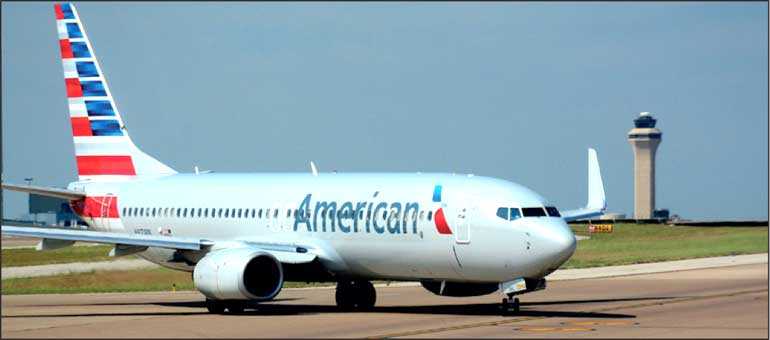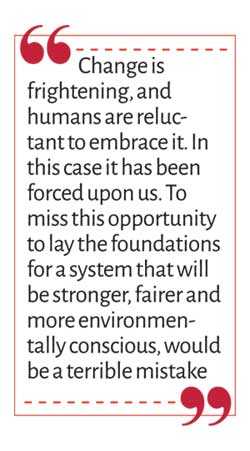Tuesday Apr 22, 2025
Tuesday Apr 22, 2025
Monday, 30 March 2020 00:00 - - {{hitsCtrl.values.hits}}

As the entire world heads into social distancing, even the few bright spots in the airline world are being extinguished. With entire countries in lockdown and other nations facing individual states closing boundaries within the country, even large, profitable airlines such as the US ‘Big Three’, Qantas, and Indigo (of India) are seeing their fleets grounded and their balance sheets awash in red ink
As I write this column the street outside my window is eerily quiet for a weekday morning. We too are in ‘lockdown’, and the only noise heard is a gentle sighing sound as the economy collapses.
COVID-19 is proving to be a seminal event in modern history. One that will change the world in ways that we haven’t computed yet – many ‘Unknown Unknowns’, as pointed out in an earlier column.
As the entire world heads into social distancing, even the few bright spots in the airline world are being extinguished. This column theorised that airlines with strong domestic route structures would weather this storm. But with entire countries (such as India) in lockdown and other nations facing individual states closing boundaries within the country (Australia and probably the USA), even large, profitable airlines such as the US ‘Big Three’, Qantas and Indigo (of India) are seeing their fleets grounded and their balance sheets awash in red ink.
Looking back in time
Many years ago, in December 1944 to be exact, a group of men was meeting in Chicago, USA in the depths of winter – while a World War was raging not far away.
Think of what was going on at that time. For five years the entire world had been engaged in a titanic struggle. By 1944 the tide had turned. The Nazi Reich, pummelled by the Russian steamroller in the East and the Allied invasion in the West, was being slowly strangled. American and British forces were gradually pushing the Japanese Empire back, island by island, at a terrible cost.
Meanwhile, heavy bombers, of a size and speed hardly imaginable a few years ago, were reducing German and Japanese cities to rubble. In a few months they would unleash a weapon so awesome that it would bring the war to an abrupt end.
Laying the foundation for civil aviation
Sequestered in a Chicago hotel, those bureaucrats representing 55 countries went on to draft a document that laid the foundation for the world’s civil aviation infrastructure.
Known as the ‘Chicago Convention’ the intent of the conference was to allow for the development of international civil aviation “…in a safe and orderly manner”, and such that air transport services would be established “on the basis of equality of opportunity and operated soundly and economically.”
The convention went on to establish an agency called ICAO (International Civil Aviation Organization), which would be made a part of the United Nations, and remains the governing body of all matters pertaining to civil aviation to this day.
Vision into reality
The process by which the ideals of the Chicago Convention were transformed into reality and a globe-spanning airline business was long and torturous. Most international delegates travelled to Chicago by ship and train, with perhaps a short flight in something like a DC-3.
The ‘mandarins’ could not have been expected to envision the jet transport airplane (there were none in 1944), much less the supersonic Concorde or the gigantic, double-deck Airbus A380.
The Convention established what is known as the ‘Five Freedoms of the Air’, that set out to regulate air commerce between nations. This laid the foundation for ‘bilateral’ agreements between nations that were envisaged to ensure a fair share of the traffic flows between points.
However, an implied (but never stated) ‘sixth freedom’, allowed some geographically well placed airports to become ‘super connectors’. They were able to use their bases as a transit point (‘hub and spoke’ in airline-speak) between places that the other five freedoms did not allow them to carry traffic.
The regulated and staid world that the Chicago conventioneers imagined has been replaced by this new reality. One where large, well-capitalized airlines dominate the market, the ‘super connectors’ with their sprawling airports or the Low-Cost Carriers (LCCs) at the other end of the scale.
The plight of today’s many ‘flag carriers’ hobbled by restrictive government, saddled in debt and unable to compete with their more successful privately-owned rivals, would have appalled the people who drew up the concept.
An opportunity for change
The aftermath of the COVID-19 pandemic will mean, among other things, that the world of civil aviation will have undergone a paradigm shift. Most authoritative sources give it between 12-24 months before the pandemic is fully contained and normal travel patters could be re-established.
Many airlines will have ceased to exist by then. Even those with the resources to have survived, will face a very different world. One where the people may not have the means (or the inclination) to travel with anywhere near the frequency of the pre-COVID era.
The hiatus that is upon us now is going to cause extreme hardship to the entire travel industry. But it does allow an excellent opportunity for the world community to meet and formulate a plan for success that will ensure that the airline system emerges from this debacle in a positive manner.
Change is frightening, and humans are reluctant to embrace it. In this case it has been forced upon us. To miss this opportunity to lay the foundations for a system that will be stronger, fairer and more environmentally conscious, would be a terrible mistake.
Discover Kapruka, the leading online shopping platform in Sri Lanka, where you can conveniently send Gifts and Flowers to your loved ones for any event including Valentine ’s Day. Explore a wide range of popular Shopping Categories on Kapruka, including Toys, Groceries, Electronics, Birthday Cakes, Fruits, Chocolates, Flower Bouquets, Clothing, Watches, Lingerie, Gift Sets and Jewellery. Also if you’re interested in selling with Kapruka, Partner Central by Kapruka is the best solution to start with. Moreover, through Kapruka Global Shop, you can also enjoy the convenience of purchasing products from renowned platforms like Amazon and eBay and have them delivered to Sri Lanka.
Discover Kapruka, the leading online shopping platform in Sri Lanka, where you can conveniently send Gifts and Flowers to your loved ones for any event including Valentine ’s Day. Explore a wide range of popular Shopping Categories on Kapruka, including Toys, Groceries, Electronics, Birthday Cakes, Fruits, Chocolates, Flower Bouquets, Clothing, Watches, Lingerie, Gift Sets and Jewellery. Also if you’re interested in selling with Kapruka, Partner Central by Kapruka is the best solution to start with. Moreover, through Kapruka Global Shop, you can also enjoy the convenience of purchasing products from renowned platforms like Amazon and eBay and have them delivered to Sri Lanka.